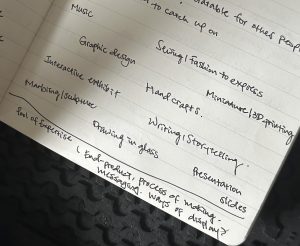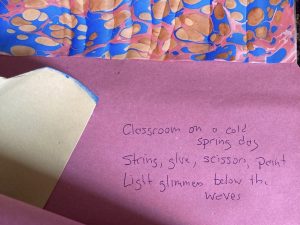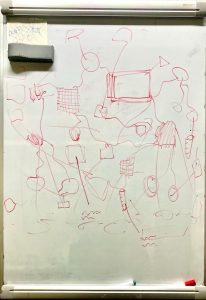When Vice-Provost Mary Ryan said: ‘Yours is an ethics project’, I had to start thinking.
Two years ago I started The Good Science Project. My idea, as told to Mary, was simplicity itself: the research culture in which we flourish will be one where conversation and debate, on contextual issues as well as ‘scientific topics’, are nurtured. I would set up brief, in person, lunch-included, discussion meetings – the Friday Forums. Nothing much, but it would help. At this point Mary said to me ‘That sounds good, this is an ethics project’.
I went away and asked myself: is communication-within-an-institution, however thoughtful and illuminating, a matter of ‘ethics’? Is Mary right?
The history of the phrase ‘research culture’ gives us a clue why the topic might indeed be an ethical issue. For the previous word we used was ‘misconduct’. As I write in a previous blog, the ancestor to our interest in research culture is a concern about trust. At the start of the millennium a number of high-profile cases from across the world made journal editors in particular, and research centres in general, worry about cheating. To a large extent the concern at that time seemed to be trust in individuals. Are some scientists ‘bad apples’, and what should we do about them? The year 2000 was also the time when the House of Lords Science Select Committee produced their epochal Third Report ‘Science and Society’. The report began with statements about a ‘crisis of trust’ in science. No particular mention was made there of misconduct or research culture, but in highlighting the concept of dialogue between science and society, the idea that the internal workings of science has civic relevance was bound to gain ground.
Thus it was that a discourse grew about science ethics being as much about institutions as it is about individuals. In 2002 and 2003 influential MRC scientist Peter Lawrence wrote for Nature magazine well-received articles on publication norms and the nature of scientific esteem. A broad conception of the culture of research institutions was the force of Sir David King’s code of conduct Rigour, Respect and Responsibility in 2007. Perhaps of greatest significance was the Nuffield Council of Bioethics 2014 report The Culture of Scientific Research in the UK, chaired by Professor Ottoline Leyser (who subsequently went on to champion these issues when she became CEO of United Kingdom Research Innovation).
All of us know that ethics is about the difference between right and wrong, about how to separate benefit from harm, and about how to advance justice rather than injustice. But all this is very abstract-sounding. How do ideas like these get traction on a laboratory? If discussions about research culture classify as an ethics project, what precisely should we discuss? Why might people gathering to discuss perspectives on their work, at a lunchtime Friday Forum, be considered to be engaging in an ethics project?
Let’s do some homework. When it comes to serious descriptions of European ethical thought, three strands exist. At the risk of being dull, I will list them. Firstly, there is deontology, or rules-based ethics. Here you know right from wrong because of rules: religious rules; rules which seem self-evident (murder is wrong; dishonesty is wrong); and, famously, ‘the golden rule’: do unto others as you would wish others would do unto you’. The philosopher most associated with rules-based ethics is Immanuel Kant (1724-1804). In science we have plenty of rules: animals, health and safety, and any number of management, HR and policy requirements.
Secondly, there is utilitarianism. This is where you judge an action by its consequences. If, all things considered, the action makes the world a better, happier place, then that action is the right one. A corollary, and a slightly disturbing one, is that the action itself does not carry particular moral weight. For example, perhaps in some circumstances killing, or telling lies, is the right thing to do, because the consequences are seen as so important. Another way of putting this is ‘the ends justifies the means’. Utilitarianism is a 19th century movement especially associated with the social reformers Jeremy Bentham (1746-1832) and J.S.Mill (1806-1873).
In science we are well-practised in using rules-based ethics, and utilitarianism, as groundings for our work. As regards utilitarianism, the resources we put into science are justified because of the future benefits that will accrue to people. Consider our College strategy: it is called ‘Science For Humanity’.
Almost automatically we think of the values of scientific research as founded on rules and on utility. The rules we set ourselves, the truth of the scientific results that we produce, and the likely future value of our work, dominate the stories we tell about our work.
But, just to give us pause, accounts of what scientists value about their work seem not quite captured by concepts of future benefit, or adherence to rules. Scientists on the contrary prefer to describe their enjoyment in their craft skills, in their steady accumulation of knowledge, and in their sense of being in a community where trusted sharing of ideas is a norm. And when they discuss their concerns about the scientific life it is the distorting impact of intense competition, too hard a fight for grants, and fears about a secure future in science research, that gain mention. And the strong sense often is that these drivers, even if accepted as inevitable and manageable, are not considered as central to scientific practice. These are not the aspects of science that make scientists happy, and cause them to think they are making progress in their understanding. Instead they are a distracting burden from the main task, a tax. We can suggest then that there is more to the life scientific than rules and future benefit. And this is where the Good Science Project comes in, and where Mary’s words prompted its strategy.
For it turns out that a third and lesser-known branch of ethics is perhaps best placed for elaborating the actual lives of scientists – virtue ethics. This is a very ancient tributary of ethical thought, stemming from the classical Greeks. Here, it is character that forms the focus, especially as regards a person’s daily commitment to their work and to their growing skills. For example, to use an example from classical Greece, a ‘good’ farmer is one who understands seed and soil behaviour and knows what needs doing when. Getting good at all these things – the steady development of skills and knowledge, and with that the steady growth of reputation – is the ethical ground for this farmer. There is no emphasis on broader rules, or on consequences. In today’s language, you might say that it is the person’s ‘practice’, and the respect it gleans within their professional community, that matters.
For the Good Science Project, virtue ethics provides the best way of responding to Mary Ryan’s declaration, and indeed establishes the point that this is ‘an ethics project’. By finding ways to help scientists articulate those aspects of daily science that normally lie hidden from view – I mean the pleasures of the technical and intellectual challenges of daily science – we can claim to be followers of Socrates and Aristotle, the very founders of European ethics.


